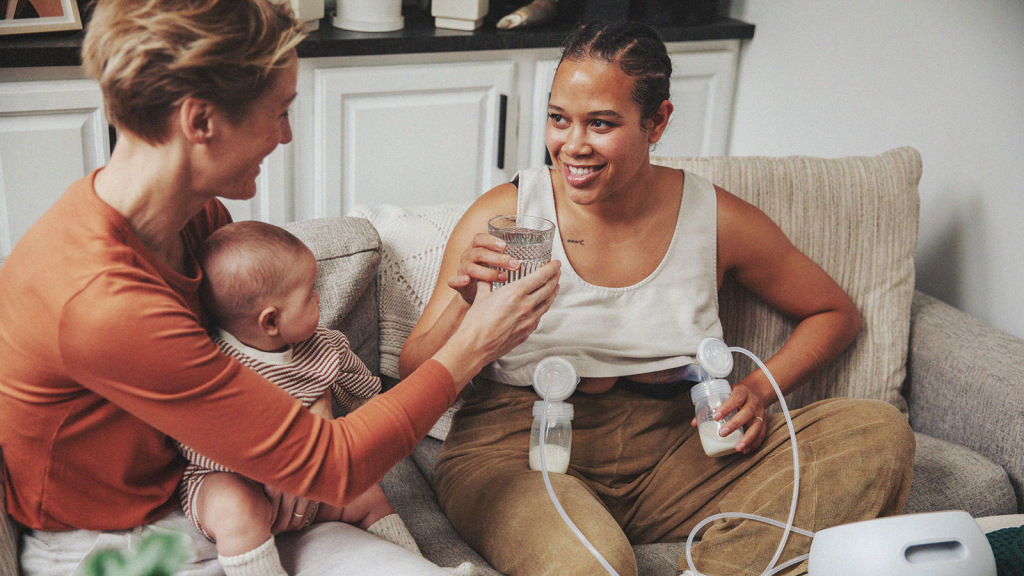Ask the IBCLC: Pumping tips from a lactation consultant
A lactation expert serves up answers to your most pressing questions
So you’re ready to start pumping — but before you break out the breast pump, you might have some questions. To help set you up for pumping success, we turned to Katie McGee, RN, International Board Certified Lactation Consultant (IBCLC), for her expert pumping tips and info. Whether you’re exclusively pumping, planning to pump at work, or building a stash for the occasional time away, here’s what you need (and want) to know about pumping breast milk.
How do I choose the best breast pump for me?
It is important to think about where you’re planning on pumping, how often you plan on pumping, and other lifestyle factors to make sure you get the right pump for you.
The majority of insurance-issued or store-bought pumps are personal double electric pumps. Our team at The Lactation Network can help connect you with an IBCLC who can help you decide on the best pump for you.
What supplies do I need for pumping?
You’ll need well-fitted breast shields (flanges), tubing, and membranes. The collection bottles that come with your pump are made to stand up to repeated usage. If you’ll be storing your milk, you’ll need clean collection bottles with lids or breast milk storage bags for the fridge or freezer. A hands-free pumping bra frees up your hands for multitasking. And don’t forget about your comfort: An inviting pumping station—complete with a cozy chair, a stash of snacks and a big water bottle—makes pumping a little more pleasant.
When should I start pumping?
The best time to start will depend on your reason for pumping, according to McGee.
“If you are a newly delivered parent with a personal plan to exclusively breastfeed, and breastfeeding is going well, there may be absolutely no need to complicate the first month of life with any pumping whatsoever,” McGee explained.
Holding off on pumping for that first month will help you establish the appropriate supply for your baby.
“At that point, it is fairly easy to add in a pumping session after a morning breastfeeding session (the time of day most women have more milk) to collect milk to have on hand without disrupting the breastfeeding relationship.”
How long and how often should I pump?
The answer here depends on whether you are pumping to replace a nursing session in addition to an effective nursing session, or if you plan to pump exclusively. While away from your baby, you’ll want to pump as often as your baby feeds. McGee explains that while the number of minutes spent pumping is important for milk production, the most crucial part is making sure you “empty” your breasts.
“Lactating breasts are never totally empty — but if you still see milk actively dripping at 15 minutes, it is important to continue,” she said. “Leaving milk behind ‘tells’ your body that you are not using much and to slow production. Emptying ‘tells’ your breasts the opposite: Send more milk.”
Most parents who are pumping to replace a nursing session will double pump (pump both breasts at the same time) until the milk stops actively dripping, typically about 20 to 30 minutes.
How much milk should I be pumping?
If you’re pumping to replace a nursing session, you’d expect to produce about as much as your baby would eat in one feeding. However, your baby is likely more effective at milk removal than your pump is, so what you pump is not always an accurate indication of your supply or how much your nursing baby is taking in. It’s good to remember that lactation comes in phases. In the early days, you’ll produce small amounts of colostrum, which is filled with highly protective proteins for your baby.
“Typically by day five for first-time parents, there is a rapid onset of milk and the small volumes quickly turn to ounces,” McGee said. “By the end of the first month, lactation is considered well-established and a target volume goal is about 32 ounces (about 1,000 milliliters) of milk produced in 24 hours.”
How do I build a backup stash? How much milk do I need?
If you’re heading back to work, start pumping about two weeks prior to your return date, one to two times per day after nursing. The volume you collect may not be large, but that’s okay.
“The fat and calorie content of that milk will likely be high after nursing because it’s hindmilk,” said McGee. “If you work five days a week, remember that the milk you pump at work on Monday can be used on Tuesday for the baby. The photos online of overflowing deep freezers can be intimidating. A freezer full of milk is rarely necessary.”
How can I pump more efficiently?
Make the process easier on yourself by having more than one set of pump parts—one of our favorite pumping tips. Set up a drying rack to keep parts organized after cleaning, and use the top rack of your dishwasher or microwave steam bags to save on sanitizing time. To help your milk flow faster, tap into your hormones and your connection to your baby.
“Pumping with an item of your baby’s close by, or watching your baby or a photo or video of your baby may help your milk flow or ‘let down’,” McGee said.
What should I do if pumping hurts?
Pumping should not hurt. “A pumping assessment from an IBCLC and a personalized pumping plan should help avoid many common problems or discomfort,” McGee said. “If pumping is hurting, get help immediately. It is important to get to the cause of the problem, solve it, and create a plan to avoid the pain from occurring in the future.”
Sore nipples are not only a (literal) pain, but they can open you up to the risk of infection. An IBCLC can help you find the best flange size for your nipples and skin elasticity, maximizing your comfort and milk output.
These pumping tips will give you a great foundation as you get started with pumping breast milk. But if you have other questions or run into issues, our patient care team at The Lactation Network is here to help. Request a consultation, and we’ll connect you to one of our IBCLCs who can provide expert information, create a personalized pumping plan, and conduct a pumping assessment.



